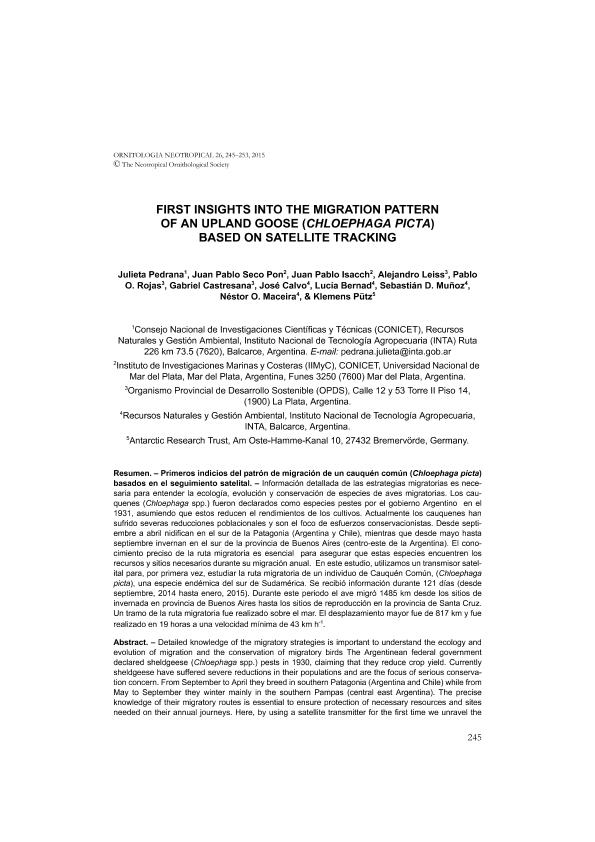Artículo
First insights into the migration pattern of an Upland goose (Chloephaga picta) based on satellite tracking
Pedrana, Julieta ; Seco Pon, Juan Pablo
; Seco Pon, Juan Pablo ; Isacch, Juan Pablo
; Isacch, Juan Pablo ; Leiss, Alejandro; Rojas, Pablo O.; Castresana, Gabriel; Calvo, José; Bernad, Lucia; Muñoz, Sebastián D.; Maceira, Nestor Oscar; Putz, Klemens
; Leiss, Alejandro; Rojas, Pablo O.; Castresana, Gabriel; Calvo, José; Bernad, Lucia; Muñoz, Sebastián D.; Maceira, Nestor Oscar; Putz, Klemens
 ; Seco Pon, Juan Pablo
; Seco Pon, Juan Pablo ; Isacch, Juan Pablo
; Isacch, Juan Pablo ; Leiss, Alejandro; Rojas, Pablo O.; Castresana, Gabriel; Calvo, José; Bernad, Lucia; Muñoz, Sebastián D.; Maceira, Nestor Oscar; Putz, Klemens
; Leiss, Alejandro; Rojas, Pablo O.; Castresana, Gabriel; Calvo, José; Bernad, Lucia; Muñoz, Sebastián D.; Maceira, Nestor Oscar; Putz, Klemens
Fecha de publicación:
12/2015
Editorial:
Neotropical Ornithological Society
Revista:
Ornitología Neotropical
ISSN:
1075-4377
Idioma:
Inglés
Tipo de recurso:
Artículo publicado
Clasificación temática:
Resumen
Detailed knowledge of the migratory strategies is important to understand the ecology and evolution of migration and the conservation of migratory birds The Argentinean federal government declared sheldgeese (Chloephaga spp.) pests in 1930, claiming that they reduce crop yield. Currently sheldgeese have suffered severe reductions in their populations and are the focus of serious conservationconcern. From September to April they breed in southern Patagonia (Argentina and Chile) while from May to September they winter mainly in the southern Pampas (central east Argentina). The precise knowledge of their migratory routes is essential to ensure protection of necessary resources and sites needed on their annual journeys. Here, by using a satellite transmitter for the first time we unravel the migration route of an Upland Goose (Chloephaga picta), a species endemic to southern South America with an unknown migration strategy. We received data for 121 days (from September 2014 to January 2015). During this time, the bird migrated 1485 km from the wintering grounds in Buenos Aires Province to the breeding area in Santa Cruz province, Patagonia. Part of the migration route was over the sea. The largest displacement was 817 km in 19 hours, representing a minimum mean speed of 43 km h-1.
Archivos asociados
Licencia
Identificadores
Colecciones
Articulos(IIMYC)
Articulos de INSTITUTO DE INVESTIGACIONES MARINAS Y COSTERAS
Articulos de INSTITUTO DE INVESTIGACIONES MARINAS Y COSTERAS
Citación
Pedrana, Julieta; Seco Pon, Juan Pablo; Isacch, Juan Pablo; Leiss, Alejandro; Rojas, Pablo O.; et al.; First insights into the migration pattern of an Upland goose (Chloephaga picta) based on satellite tracking; Neotropical Ornithological Society; Ornitología Neotropical; 26; 3; 12-2015; 245-253
Compartir



